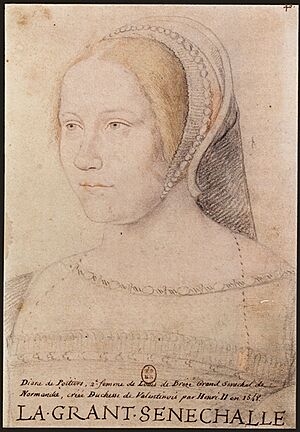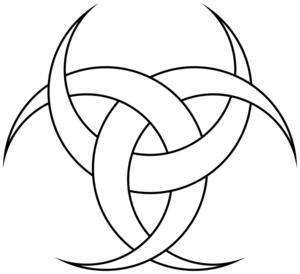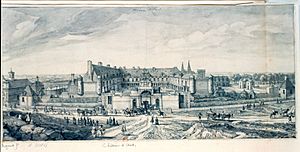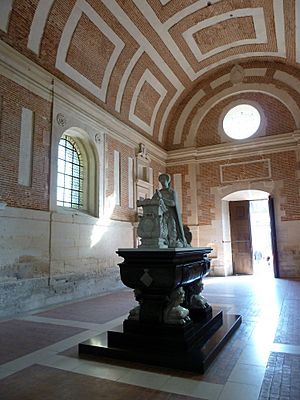Diane de Poitiers facts for kids
Quick facts for kids
Diane de Poitiers
|
|
|---|---|
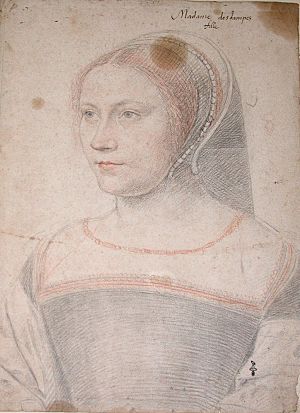
Diane de Poitiers, Jean Clouet, 1525
|
|
| Born | 9 January 1500 Château de Saint-Vallier, Drôme, France
|
| Died | 25 April 1566 (aged 66) Anet, Eure-et-Loir, France
|
| Burial place | Château d'Anet, Anet, Eure-et-Loir |
| Title | Grand Senechal of Normandy Countess of Saint-Vallier Duchess of Valentinois and Étampes |
| Spouse(s) | |
| Children | Françoise de Brézé, Princess of Sedan Louise de Brézé, Duchess of Aumale |
| Parent(s) | Jean de Poitiers, Seigneur de Saint Vallier Jeanne de Batarnay |
Diane de Poitiers (born January 9, 1500 – died April 25, 1566) was a French noblewoman. She became a very powerful and important adviser to King Henry II. She had a lot of influence until he passed away. Her position helped her family gain more wealth and status. She was also a big supporter of French Renaissance architecture, helping to build beautiful buildings.
Contents
Early Life and Education
Diane de Poitiers was born on January 9, 1500, at the Château de Saint-Vallier in Drôme, France. Her parents were Jean de Poitiers, Seigneur de Saint Vallier, and Jeanne de Batarnay. She loved sports and stayed very fit by riding horses and swimming often. She was in excellent physical shape for her time.
When she was a young girl, Diane was part of the group that served Princess Anne de Beaujeu. Anne was King Charles VIII's older sister and skillfully ruled France while he was too young. Like other young people in Anne's care, Diane received a great education. She learned about Renaissance humanism, which included subjects like Greek and Latin, public speaking, good manners, money management, law, and architecture.
Marriage and Family Life
On March 29, 1515, when she was 15 years old, Diane married Louis de Brézé. He was the lord of Anet and a very important official called the Grand Seneschal of Normandy. Louis was 39 years older than Diane. He was also a grandson of King Charles VII and worked for King Francis I. Diane and Louis had two daughters: Françoise (born 1518) and Louise (born 1521).
Soon after her marriage, Diane became a lady-in-waiting to Queen Claude of France. After Queen Claude died, Diane served the King's mother, Louise of Savoy, and then Queen Eleanor of Austria.
In 1523, Diane's husband found out about a plot against King Francis I. He didn't know that Diane's father was also involved. In 1524, Jean de Poitiers was accused of treason (betraying his country) and sentenced to death. However, his punishment was changed. He was kept in prison until a peace agreement, the Treaty of Madrid, was signed in 1526.
After her husband died in 1531, Diane wore black and white clothes for the rest of her life. These were colors for mourning (showing sadness for someone's death). They also represented the moon, which was a nod to her name, Diane, like the Roman moon goddess Diana. She hired a sculptor named Jean Goujon to build a tomb for Louis in the Rouen Cathedral.
Diane was very good with money and legal matters. She managed to keep her late husband's income as Grand Seneschal of Normandy. She also fought in court to keep her family's lands. King Francis I was impressed. He allowed Diane, even though she was a widow, to manage her inherited estates and keep the large amounts of money they brought in.
Close to the King
In 1525, King Francis I was captured by enemy troops. In 1526, his sons, Francis and Henry, were sent to Spain as hostages. The boys, who were eight and seven years old, spent almost four years alone in a castle. This difficult experience may have made Diane's kindness even more important to Henry. She was like an ideal gentlewoman to him. She gave him a farewell kiss when he was sent to Spain.
At a tournament in 1531, Henry wore Diane's colors, even though he was expected to wear the colors of the new Queen. This showed how much he admired her.
In 1533, Henry married Catherine de' Medici. Many at the French court did not like this marriage because the Medicis were seen as just merchants. However, Diane approved of Catherine. Diane and Catherine were actually distant cousins. It is believed that Diane became Henry's close companion in 1534. She was 35 years old, and Henry was 15.
Henry and Catherine did not have children for a while. Diane was worried that Catherine might be sent away. So, Diane made sure Henry visited Catherine often. This led to them having ten children together. Diane also helped nurse Catherine when she was sick.
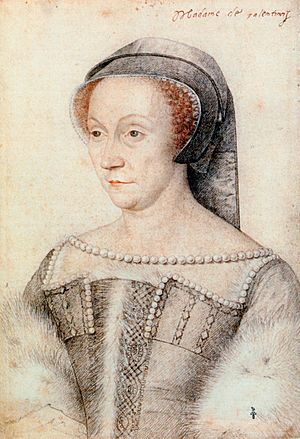
Diane remained Henry's lifelong companion. For the next 25 years, she was one of the most powerful women in France. When Henry's father, Francis I, was still alive, Diane had to compete with his companion. In 1544, Henry's father banished Diane. Henry and his supporters went to the chateau of Anet. Father and son did not make up until 1545.
After Francis I died, Henry became king. He removed his father's companion from court. By then, Diane was so important that when the Pope sent the new Queen a special gift, he also gave Diane a pearl necklace. She received the important title of Duchess of Valentinois in 1548 and Duchesse d'Étampes in 1553. Her sons-in-law also received important jobs because of her influence.
Diane was very smart and loyal to Henry II. She became his most trusted helper at court. He trusted her to write many of his official letters. They were even signed with one name: "HenriDiane." Until 1551, she was in charge of Henry's children's education. She also helped raise Diane of France, Henry's daughter with another woman. Diane treated her as if she were her own child. Diane's daughter, Françoise, managed the Queen's household.
The King's love for Diane made Queen Catherine very jealous. Especially when Henry gave Diane the Crown Jewels of France and the Château de Chenonceau. Catherine wanted Chenonceau for herself. But as long as the King was alive, the Queen could not change anything.
Building Projects
Diane was very careful with money. She made a lot of money from lands she managed. She became one of the wealthiest royal companions. Diane used her money to build castles. She hired a famous architect named Philibert de l'Orme. She used art and ideas from the Renaissance to present herself as a very good person and Henry II as a brave knight.
Diane oversaw the changes to Château d'Anet, her late husband's castle. It has a beautiful porch with columns and towers. The château is famous for its outside features, especially the Fountain of Diana. This fountain shows Diane as the goddess Diana, resting with her two dogs and a deer. There is also a chapel built for Diane's tomb, which her daughter Louise had built.
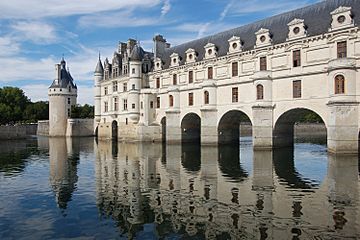
Diane was also the owner of the Château de Chenonceau, a beautiful palace in the Loire Valley. In 1555, she asked de l'Orme to build an arched bridge connecting the château to the other side of the river. She also supervised the planting of large gardens filled with many kinds of fruit trees. Her beautiful gardens along the river were very famous and copied by others.
Later Years
Diane's power depended on the King's well-being. In 1559, Henry was badly hurt in a jousting tournament. He was wearing Diane's ribbon, not his wife's. Queen Catherine quickly took control. She stopped people from seeing the King. Even though Henry was said to have called for Diane many times, she was not allowed to see him before he died. She was also not invited to his funeral.
Immediately, Queen Catherine made Diane give up the Château de Chenonceau. In return, Diane received the less attractive Château de Chaumont. This punishment was much less severe than what other royal companions faced.
Diane spent her last years at her château in Anet, Eure-et-Loir. She lived a quiet life there, almost like she was in exile. At 64, she fell during a horse ride and never fully recovered. She died a year later. Her daughter completed the funeral chapel near the castle, where Diane wanted to be buried.
During the French Revolution, Diane's tomb was opened. Her body was disrespected, and her remains were thrown into a mass grave. In 1866, her letters were published. When experts found her remains in 2009, they found high levels of gold in her hair. It is thought that a "drinkable gold" she supposedly took to stay young might have caused her death. In May 2010, she was reburied in her original tomb at the Château d'Anet.
See also
 In Spanish: Diana de Poitiers para niños
In Spanish: Diana de Poitiers para niños
- List of French royal mistresses
- Fountain of Diana


